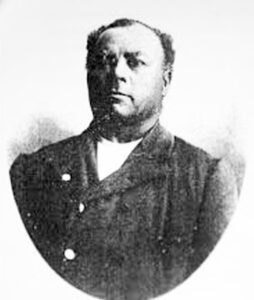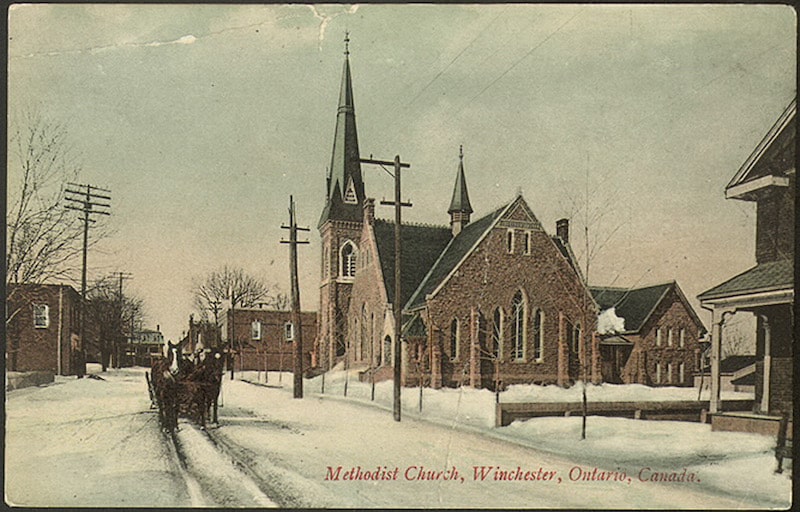by Susan Peters, Dundas County Archives
On February 10, 2021, the North Dundas Times published a short article that I had written on Isaac Johnson (1844 – 1905). His impact on this region was significant. So significant, in fact, that others have reached out to me about Isaac’s story. As a result, I have been digging back into the research on his origins in slavery, as well as the incredible work he left us through his stone masonry.

Isaac was born in slavery in 1844 in Nelson County, Kentucky. His mother, Jane, was an enslaved woman from Madagascar. His father was Richard Yaeger, a white tobacco farmer. Isaac wrote in his memoirs that he had no idea that either his mother or he were slaves until he was 7 years old. His father encountered financial problems when Isaac was about 7 years old and he found himself on the slave auction block in 1851, along with his mother and brothers Louis, Ambrose, and Eddie. One cannot imagine the level of distress he would have encountered at such a young age. It is unfathomable for him to learn that his father had sold them away as property. He noted that he was sold for $700, and the entire family earned $3,300 for his father. This was a substantial amount at this time. Isaac was sold to William Mattingly, and he began his life as an enslaved child. He was transferred to William’s brother John’s stock farm where he labored for 12 years. His brothers and mother were the property of other owners and Isaac lost track of them.
In 1901, Isaac Johnson wrote his memoirs,”Slavery Days in Old Kentucky: A true story of a father who sold his wife and four children. By one of the children”. He published his memoirs to raise funds for the education of his children. He also wrote his story to connect with any of his family left in Kentucky. He had hoped that by sharing his story he might be able to find his brothers or his mother. While he did manage to raise awareness of the impact of slavery, and he did earn some income to pay for his children’s education, he was not successful in trying to locate any family.
It is not known if he planned to eventually end up in Canada, but his memoirs do tell us about “Bob the Canadian” who was also enslaved at Mattingly’s farm. Bob was a free man who was taken illegally into custody in Louisiana and sold to Mattingly. Bob was an example of how, under the Fugitive Slave Act, any black man could be kidnapped and sold into slavery. While toiling on the farm together, Isaac and Bob planned an escape. Unfortunately, Bob was captured and tortured to death and the escape failed.
We know through his memoirs, and Civil War military and pension records, that his opportunity to gain his freedom came through the War between the States. In 1864, he joined the Union Army in Detroit with the 102nd Colored Troops Regiment. He saw action in South Carolina at Honey Hill, where he was injured. He lost a finger and was hospitalized for other injuries. He was mustered out at Detroit. This is essentially where his memoirs end, and the story must be researched in other ways.
Johnson reported in his pension application that he returned to Kentucky after the war. He did find John Mattingly, but he was not successful in finding his family. How he ended up in this area is anyone’s guess. We do know that after the Civil War, he ended up working on steamships in the Great Lakes. His pension application does state that by 1867 he was in Morrisburg. While he did not appear in the census for that time here, we do know that he was here at least by 1875, as he married Louisa Theodosia Allen in Morrisburg. The marriage announcement appeared in the Dundas Courier on December 28, 1875. Their marriage record confirmed this.
 It is not known where Isaac picked up the skills of a stonemason; presumably, it was on-the-job training as a stone cutter. He was known to take on construction jobs where he could. The record of his children’s births helps to place him on several major projects. We know that their first child, Gertrude, was born on October 7, 1876, in Morrisburg. Their daughter, Susan, was born in Winchester in June 1881. In March 1883, their daughter Alice was born, and daughter Hattie in June, 1885, also in Winchester. During this time, he was working for the Baker Limestone Quarry near Winchester. Baker had the contract to construct the United Church in Winchester and likely Isaac was working on that project. When Baker was injured, Isaac took over the management of the church construction project. His other projects included the St James Anglican Church in Morrisburg and homes in Winchester and Russell. He also took on projects in Waddington, New York. The border was pretty fluid at this time.
It is not known where Isaac picked up the skills of a stonemason; presumably, it was on-the-job training as a stone cutter. He was known to take on construction jobs where he could. The record of his children’s births helps to place him on several major projects. We know that their first child, Gertrude, was born on October 7, 1876, in Morrisburg. Their daughter, Susan, was born in Winchester in June 1881. In March 1883, their daughter Alice was born, and daughter Hattie in June, 1885, also in Winchester. During this time, he was working for the Baker Limestone Quarry near Winchester. Baker had the contract to construct the United Church in Winchester and likely Isaac was working on that project. When Baker was injured, Isaac took over the management of the church construction project. His other projects included the St James Anglican Church in Morrisburg and homes in Winchester and Russell. He also took on projects in Waddington, New York. The border was pretty fluid at this time.
We know that by 1889 they were in Waddington, where their twins Louise and Isaac were born. Their son Daniel was born in January 1893, also in New York. During this time Isaac was busy building the Waddington Town Hall, a stone bridge at Chamberlain’s Corners, and several other projects in Northern New York. In 1889, he was injured in a quarry accident which ended his construction career. He died on December 5, 1905, in Ogdensburg New York. Isaac Johnson left quite a legacy between his family, his published memoirs, and the enduring legacy of his stone buildings. He stands as a man to be honoured and appreciated. He rose from slavery to be a well-respected stone mason. My respect for this man is unwavering. As such, the research continues.

